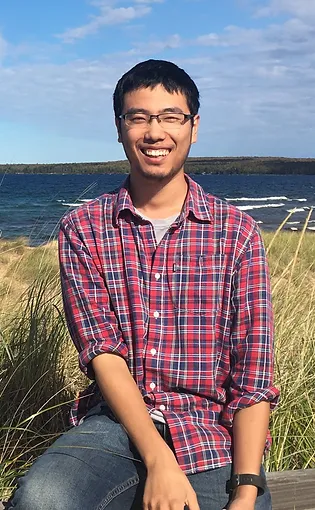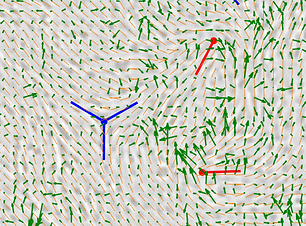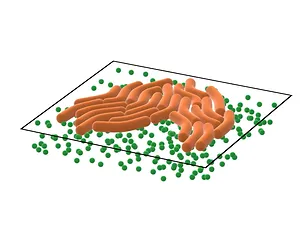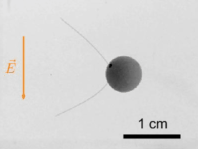Principal Investigator
Endao Han
Employment
2023 – present Assistant Professor, Division of Physics and Applied Physics, Nanyang Technological University, Singapore.
2018 – 2023 Associate Research Scholar / CPBF Fellow, Center for the Physics of Biological Function and Department of Physics, Princeton University, USA.
Education
2012 – 2018 Ph.D. in Physics, University of Chicago, USA
2010 – 2012 MPhys (Hons), University of Manchester, UK
2007 – 2011 B.S. in Physics, Shandong University, China
Office: SPMS-PAP-03-09
Email: endao.han@ntu.edu.sg

Research Projects
The future research of our lab focuses on the mechanics of active and living matter. The two major directions are: (i) collective motion of bacteria and mechanics of bacterial biofilms; (ii) artificial active fluids and solids. Both directions are built on a common basis - developing and exploiting state-of-the-art experimental and data processing techniques.

Collective motion of bacteria
A normal fluid becomes turbulent when flowing very fast and solidifies as the temperature decreases (e.g. in glass transitions). Such chaotic or jammed regimes have been observed in colonies of cells as well, but the underlying physics is still poorly understood. My lab develops advanced experimental platforms that enable direct measurements of virtually all the relevant variables, including nematic order, polar order, mechanical stress, cell velocity, cell concentration, etc. This allows us to test existing theories and seek a systematic understanding of the collective motion of bacteria.

Measure mechanical stress in living systems
Bacteria rely on mechanical forces to achieve many biological functions, such as locomotion, attachment, and aggregation. At the same time, they actively sense their ambient environment and respond to mechanical cues. To understand certain behaviors of bacterial colonies or biofilms, accurate measurements of these forces are crucial from the scale of an individual cell to the whole structure. My lab develops experimental and data processing tools that better visualize biological systems, quantify their internal mechanical stress, and characterize their material properties such as elastic modulus and viscosity.

Artificial active materials
By pumping energy into an otherwise inert system, one can create artificial active matter with unique material properties such as odd viscosity and odd elasticity. Relevant research not only leads to exciting new physics but also has potential applications in materials science and robotics. To make a robotic hand pour a glass of water, one could control all its 20-ish degrees of freedom individually. However, for an advanced soft robot like T-1000 in Terminator 2, which has thousands and millions of degrees of freedom, a similar approach simply does not work. A proper understanding of the constitutive relations of active fluids and solids is crucial in designing and controlling such systems.
Publications
# Corresponding author
* Equal contribution
Pre-prints
- E. Han#, C. Fei, R. Alert, K. Copenhagen, M. D. Koch, N. S. Wingreen, and J. W. Shaevitz#. Spontaneous polar order controls morphology and mechanical stress in developing Myxococcus xanthus colonies. arXiv preprint arXiv:2308.00368 (2023).
- N.Y. Jolivet, E. Han, A. Belgrave, N. Koushki, D. Lemon, B. Fleuchot, L.M. Faure, F. Saïdi, U. Mahanta, H. Jiang, G. Sharma, J. Fiche, B.P. Bratton, M. Diallo, B. Nan, D.R. Zusman, G. Sudre, A. Garza, M. Nollmann, A.J. Ehrlicher, O. Theodoly, J.W. Shaevitz, T. Mignot, S.T. Islam#. Integrin-like adhesin CglD confers traction and stabilizes bacterial focal adhesions involved in myxobacterial gliding motility. bioRxiv 2023.10.19.562135 (2023).
Before NTU
- M. D. Koch, M. E. Black, E. Han, J. W. Shaevitz#, and Z. Gitai#. Pseudomonas aeruginosa distinguishes surfaces by stiffness using retraction of type IV pili. PNAS, 119 (20) e2119434119 (2022).
- M. A. Reyes-Martinez, E. P. Chan#, C. L. Soles, E. Han, K. A. Murphy, H. M. Jaeger, D. R. Reid, and J. J. de Pablo. Tuning the mechanical impedance of disordered networks for impact mitigation. Soft Matter, 18 (10), 2039-2045 (2022).
- E. Han#, L. Zhu, J. W. Shaevitz, and H. A. Stone#. Low-Reynolds-number, biflagellated Quincke swimmers with multiple forms of motion. PNAS, 118 (29) e2022000118 (2021).
- S. Pravin*#, B. Chang*, E. Han, L. London, D. I. Goldman, H. M. Jaeger, and S. T. Hsieh#. Effect of two parallel intruders on total work during granular penetrations. Physical Review E, 104 (2), 024902 (2021).
- L. K. Roth, E. Han, and H. M. Jaeger#. Intrusion into granular media beyond the quasistatic regime. Physical Review Letters, 126 (21), 218001 (2021).
- Y. Fang*#, E. Han*, X. Zhang*, Y. Jiang*, Y. Lin, J. Shi, J. Wu, L. Meng, X. Gao, P. J. Griffin, X. Xiao, H. Tsai, H. Zhou, X. Zuo, Q. Zhang, M. Chu, Q. Zhang, Y. Gao, L. K. Roth, R. Bleher, Z. Ma, Z. Jiang, J. Yue, C. Kao, C. Chen, A. Tokmakoff, J. Wang, H. M. Jaeger#, and B. Tian#. Dynamic and programmable cellular-scale granules enable tissue-like materials. Matter, 2, 948-964 (2020).
- E. Han#, N. M. James, and H. M. Jaeger. Stress controlled rheology of dense suspensions using transient flows. Physical Review Letters, 123 (24), 248002 (2019).
- E. Han*, L. Zhao*, N. Van Ha, S. T. Hsieh, D. B. Szyld, and H. M. Jaeger#. Dynamic jamming of dense suspensions under tilted impact. Physical Review Fluids, 4 (6), 063304 (2019).
- N. M. James, E. Han, R. A. Lopez de la Cruz, J. Jureller, and H. M. Jaeger#. Inter-particle hydrogen bonding can elicit shear jamming in dense suspensions. Nature Materials, 17, 965-970 (2018).
- E. Han#, M. Wyart, I. R. Peters, and H. M. Jaeger. Shear fronts in shear-thickening suspensions. Physical Review Fluids, 3 (7), 073301 (2018) (Editors’ Suggestion).
- F. Box#, E. Han, C. R. Tipton, and T. Mullin. On the motion of linked spheres in a Stokes flow. Experiments in Fluids, 58 (4), 29 (2017).
- S. Majumdar#, I. R. Peters, E. Han, and H. M. Jaeger. Dynamic shear jamming in dense granular suspensions under extension. Physical Review E, 95 (1), 012603 (2017).
- E. Han, N. Van Ha, and H. M. Jaeger#. Measuring the porosity and compressibility of liquid-suspended porous particles using ultrasound. Soft Matter, 13 (19), 3506-3513 (2017).
- E. Han, I. R. Peters, and H. M. Jaeger#. High-speed ultrasound imaging in dense suspensions reveals impact-activated solidification due to dynamic shear jamming. Nature Communications, 7, 12243 (2016).
- K. Singh#, C. R. Tipton, E. Han, and T. Mullin. Magneto-elastic buckling of an Euler beam. Proc. R. Soc. A, 469 (2155), 20130111 (2013).
- C. R. Tipton, E. Han, and T. Mullin#. Magneto-elastic buckling of a soft cellular solid. Soft Matter, 8 (26), 6880-6883 (2012).
Books
- E. Han, Transient Dynamics of Concentrated Particulate Suspensions Under Shear, Springer, 2020.
Openings
There are two PhD positions with full scholarships, starting Fall 2024. The PhD students will be affiliated with the Division of Physics and Applied Physics at NTU.
We are also looking for one postdoc. The starting time is flexible. Candidates with experience in optics, microscopy, or biophysics are preferred.
Interested candidates could email a CV, a cover letter, transcripts, and the contact information of at least two referees to Endao Han (endao.han_at_ntu.edu.sg). Please describe your research interests in the cover letter. For postdoc candidates, please also briefly describe your research experience in the cover letter. Kindly note that only shortlisted candidates will be contacted.
